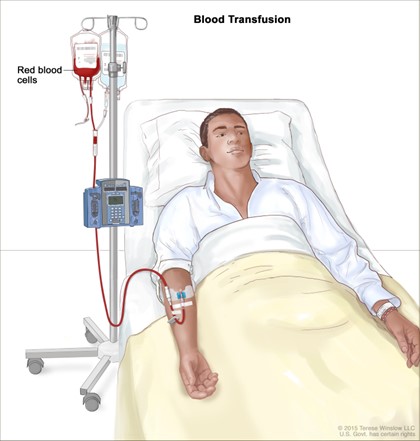A nurse is monitoring a client who is receiving 2 units of packed RBCs.
Which of the following manifestations indicates a hemolytic transfusion reaction?
Back pain.
Bradycardia.
Hypertension.
Chills.
The Correct Answer is A
The correct answer is A. Back pain.
Choice A reason: Back pain during a blood transfusion is a classic symptom of a hemolytic transfusion reaction. This type of reaction occurs when the immune system attacks the transfused red blood cells, leading to their destruction. Back pain is considered a more specific and early sign of this reaction.
Choice B reason: Bradycardia, which is a slower than normal heart rate, is not typically associated with hemolytic transfusion reactions. The normal range for an adult’s resting heart rate is between 60 to 100 beats per minute. Bradycardia is usually considered when the heart rate is lower than 60 beats per minute in a resting adult. It can be a sign of a well-trained athlete or can occur as a result of certain medications or heart conditions, but it is not a recognized symptom of a hemolytic transfusion reaction.
Choice C reason: Hypertension, or high blood pressure, is also not a common symptom of a hemolytic transfusion reaction. Normal blood pressure ranges from 90/60 mmHg to 120/80 mmHg. Hypertension is typically defined as having a blood pressure higher than 130/80 mmHg. While hypertension can be a serious condition, it is not indicative of a hemolytic transfusion reaction.
Choice D reason: Chills are a symptom that can be associated with a hemolytic transfusion reaction, often occurring alongside fever and back pain. However, while chills can indicate a reaction, back pain is a more specific symptom that can help differentiate a hemolytic reaction from other types of transfusion reactions.

Nursing Test Bank
Naxlex Comprehensive Predictor Exams
Related Questions
Correct Answer is A
Explanation
This statement indicates an understanding of the teaching because headache is a common symptom of anemia.
 Choice B is incorrect because bradycardia (slow heart rate) is not a common symptom of anemia.
Choice B is incorrect because bradycardia (slow heart rate) is not a common symptom of anemia.
Instead, anemia can cause irregular heartbeats or a fast heartbeat.
Choice Dis incorrect because flushed skin color is not a common symptom of anemia.
Instead, anemia can cause pale or yellowish skin 1.
Choice Cis incorrect because heat intolerance is not a common symptom of anemia.
Correct Answer is A
Explanation
The nurse’s priority assessment in the PACU (Post-Anesthesia Care Unit) should be the client’s respiratory status.

This is because the client is recovering from anesthesia and may have an altered respiratory function.
Choice B, assessing the surgical site, is not an answer because it is not the priority assessment for a client in the PACU.
Choice C, assessing the level of consciousness, is not an answer because it is not the priority assessment for a client in the PACU.
Choice D, assessing the pain level, is not an answer because it is not the priority assessment for a client in the PACU.
Whether you are a student looking to ace your exams or a practicing nurse seeking to enhance your expertise , our nursing education contents will empower you with the confidence and competence to make a difference in the lives of patients and become a respected leader in the healthcare field.
Visit Naxlex, invest in your future and unlock endless possibilities with our unparalleled nursing education contents today
Report Wrong Answer on the Current Question
Do you disagree with the answer? If yes, what is your expected answer? Explain.
Kindly be descriptive with the issue you are facing.
